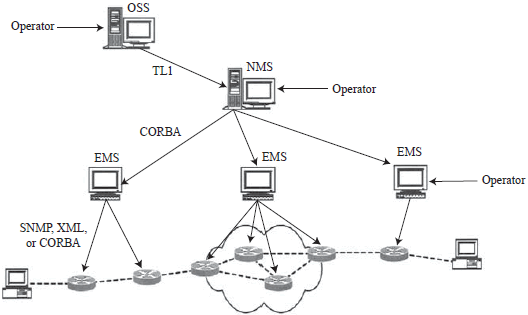Standardized Data Representations and Access
Network managers dream of having a single application that they can use to manage their entire network. This application must be capable of controlling all of the devices in the network, and of collecting and integrating the information and statistics stored on each device. The advantages for the operator are a coherent view and a less complex management task because he or she doesn't have to learn to speak the different command languages for the different equipment vendors and the different dialects for the different devices and models from the same vendor.
One approach to building the global network management tool is to incorporate modules designed to talk to each of the individual components and map these to a common display and control component. This is hard work for the writer of a management application since he or she has to keep up with the latest command syntaxes and products produced by each vendor. This is, however, a viable solution, especially if a modular approach is taken.
One easier way to produce a global management tool is to make the individual vendors responsible for the modules that manage all of their devices and to make those modules distinct (usually running on separate computers) with a northbound interface to the global application. This can be seen in Figure below, in which the operator works at a network management system (NMS) or through an operations support system (OSS) such as Telcordia's TIRKS or NMA. Use of an OSS allows the operator to utilize sophisticated provisioning and accounting services, and the OSS uses a scripting language such as TL1 to pass CLI-like commands on to the NMS. The NMS is the global management application that communicates to many element management systems (EMSs), each of which is responsible for managing a collection of devices of the same type. It is the EMS that the equipment vendor supplies as a distinct module for incorporation into the whole management network.

The management network can be built up from a series of management systems so that the operator can use a single, central management server.
As shown in Figure above, the operator may have access to the EMSs where he or she uses proprietary CLIs and GUIs to control the devices. But if the operator is working at the NMS or OSS there must be a channel of communications between the NMS and each EMS. This is popularly referred to as a northbound interface to the EMS. There are two requirements for this communication: (1) the messages must be understood universally (there must be a common communications protocol), and (2) the data must be comprehensible (there must be a common data format). The popular standard for NMS to EMS communications is the Common Object Request Broker Architecture described later. CORBA provides a standardized way for the NMS to access data objects managed by each EMS, and a way for the equipment vendors or EMS authors to publish a database format for the NMS to access. These formats can become standardized, making the job even simpler.
The EMS is now free to manage the devices themselves. Each equipment vendor may take a different approach to the management of its devices, as described in the previous section, but it is increasingly popular to use one of a small set of standardized protocols and data formats. There is a clear advantage for vendors because they are able to leverage lots of existing code when they produce a new device and they do not have to make substantial upgrades to their EMS to support the new product. Three popular standards-based confi guration techniques have emerged: CORBA, SNMP, and XML. If CORBA is used by the EMS to manage its devices, the mapping between the NMS and a device is particularly simple for the EMS, but otherwise a conversion component must be written.
However, once the devices support a standardized confi guration protocol, there is less need for an EMS. It does continue to add management features specifi c to the vendor's equipment, but it gets in the way of centralized management from the NMS and affects management performance if translations are required on every command. For this reason, the EMS is increasingly dropped from the picture and the NMS communicates with the devices directly using one of the standardized protocols.
In this tutorial:
- IP Network Management
- Choosing to Manage your Network
- Choosing a Configuration Method
- Command Line Interfaces
- Graphical User Interfaces
- Standardized Data Representations and Access
- Making the Choice
- Management Information Base
- Representing Managed Objects
- Simple Network Management Protocol
- Requests, Responses, and Notifications
- SNMP Versions and Security
- Choosing an SNMP Version
- Extensible Markup Language
- Extensibility and Domains of Applicability
- XML Remote Procedure Calls
- Simple Object Access Protocol
- XML Applicability to Network Management
- Common Object Request Broker Architecture
- Interface Definition Language
- The Architecture
- CORBA Communications
- Choosing a Configuration Protocol
- Choosing to Collect Statistics
- Policy Control
- Choosing to Apply Policy
- Policy Information Base
